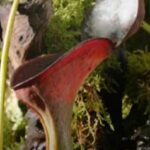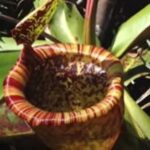As an Amazon Associate, this site earns commissions from qualifying purchases. For more details, click here.
The idea of having carnivorous plants like nepenthes inside your home might seem weird or even risky. But the truth is pitcher plants are perfect for indoors. As a decorative plant, nepenthes will certainly stand out from the typical houseplant and they are also safe for humans and pets. But there are many other reasons why you should consider getting one or more for your home.
Pitcher plants are ideal houseplants because they are easy to care for. Just leave the plant on a sunny windowsill, water regularly and it will grow. Pitcher plants also feed on flies and other bugs that pester your home and garden.
Easy to Grow and Care For
Pitcher plants have different care requirements, but if the species is native to your region, caring is straightforward. By getting a nepenthes or sarracenia that naturally grows in your area, you do not have to worry about the plant trying to adjust to a new environment.
Pitcher plants only grow in poor soil, which must always be kept moist. Most nepenthes thrive in temperatures between 65-85 degrees F (22-32 C) and high humidity. This is a general guideline though as local species have different tolerance levels.
The benefit of growing pitcher plants indoors is you can control the humidity and temperature. And if the plant is native to the place, you do not even have to do much adjustment. Just make sure the plant receives enough light, water, food and the right soil, and it will be fine. That is literally all there is to caring for nepenthes.
Soil, Pot and Water
Pitcher plants can grow in any media as long as it lacks nutrition. The best option is 1:1 peat moss and perlite or 1:1 long sphagnum moss and silica sand. You can use plastic containers as pots or a terrarium. The pot should be at least 5 inches so there is room for the roots to grow.
The soil must always be moist. Never let the soil go totally dry as it could kill the plant. Water the nepenthes from the top just like any houseplant. Keep pouring water until the liquid flows out from the pot drain hole.
Water as often as necessary to keep the soil moist. Use a device like the XLUX Soil Moisture Meter to check the moisture level of the soil. Higher temperature causes water to evaporate faster so you have to adjust your watering frequency accordingly.
This is not as hard it seems. If you have ever watered regular houseplants before, the process is the same with nepenthes. The only difference is pitcher plants like nepenthes need a bit more moisture in their soil. If humidity is high the soil will stay moist longer.
Easy to Feed
This is one of the most exciting aspects of keeping pitcher plants, and it is also one that is often misunderstood. In truth, feeding pitcher plants is very easy indoors.
Indoor pitcher plants can survive on just one bug a month. You can drop an small bug into its pitcher and the plant will eat it. If there are no bugs available, you can feed it fish flakes, fish pellets or freeze dried mealworms or bloodworms.
Pitcher plants are safe around humans and pets, and feeding is easy. Among the misconceptions is that you need expertise to feed them and that it takes a lot of time. Both are not true.
Pitcher plants eat bugs to get nutrients which are not in the soil. The plant will not consume anymore than it requires. If you stuff the pitcher with bugs, they will just rot there, so better stick with the once a week or once a month feeding cycle.
Feeding nepenthes is straightforward. First, decide what food to give it. Nepenthes eats live and dead bugs of all types. If you do not want to mess with insects, try Blue Ridge Fish Food Pellets or freeze dried mealworms. These are just as nutritious as live insects and easy to buy.
To feed a pitcher plant, drop the food into one of its pitchers. Again you only have to supply food to the plant 1-4 times a month. Do not fill the entire pitcher with food .You can place also place the plant on a windowsill and it should be able to catch plenty of bugs by itself. Outdoor nepenthes do not have to be given any food.
Where to Place Pitcher Plants
You can place nepenthes anywhere in your home as long as there is a light source. A sunny windowsill is the best option if you want natural light for your plant. If that is not possible, you can use grow lights anywhere in your home.
First, pitcher plants do not actually have to eat bugs to live. They can survive on light and water because they produce food through photosynthesis. That is why placement is important because these plants need light, natural or artificial.
Pitcher plants require 6-8 hours of bright light each day. If sunlight is limited, use artificial lighting. The combination of natural and artificial light will help nepenthes grow and stay healthy.
The simplest approach is to find a south facing window. Leave the pitcher plant there to absorb the light and energy. As long as the temperature does not exceed 100 degrees the plant will be all right.
Nepenthes do not require dormancy so you can keep them indoors the entire time. During its growth period you can rely on natural light most of the time. During winter or rainy days, use T5 fluorescent lights to simulate natural light. Keep the light on for several hours a day.
Conversely if it gets too hot, provide some shade for your pitcher plant. Most nepenthes prefer a combination of partial and direct light. If it gets too hot the leaves might burn out and the pitchers lose their liquids. Keep the plant under shade until the temperature drops.
Keeps Flies and Other Pests Away
If you have a fruit garden for instance, you know how annoying flies can be. By leaving a few pitcher plants in the vicinity, the flies will be drawn there instead of your fruits. Indoors, nepenthes will draw flies and other pests away from your food.
Pitcher plants are not as effective in controlling gnats, but they can get rid of the occasional housefly, spider or wasp that gets in. This is another reason why it is a good idea to keep these plants.
Tips For Caring Pitcher Plants
If you want to buy a pitcher plant for your house or apartment, here are some things to keep in mind.
- Pick a pitcher plant that grows naturally in your location. This makes it easier for the plant to adapt to your home environment.
- Provide as much light as possible. 6 hours is the minimum, and the more the better. If the temperature climbs to 100 degrees, provide cover until it drops to 90 and below.
- Some pitcher plants do not grow well in terrariums but others do. Check the growth instructions that came with your plant.
- Do not feed rats or other large animals to the plant. Pitchers are only for digesting small insects. Forcing it to eat large animals could kill the pitcher. The animal itself will probably not be eaten and left to rot.
- Do not play with pitcher plants. Do not poke the pitcher, do not fill it with water or other liquids. Do not allow pets to play with its leaves.
- Nepenthes does not go dormant but sarracenia does. You have to account for this if you want to raise those at home.
- Never use fertilized soil on pitcher plants. They get nutrients from insects and adding fertilizer to the soil will be fatal.
- Do not use tap water. Distilled water and rainwater are recommended as well as reverse osmosis water.
Conclusion
Pitcher plants are not that difficult to care for as long as you take the right approach. If you have had doubts about your ability to care for pitcher plants indoors, hopefully this guide was able to clear things up for you.

My fascination with carnivorous plants began many, many years ago with Venus Fly Traps. Now I am more than happy to impart what I know with other enthusiasts and those who are curious about meat eating plants.



